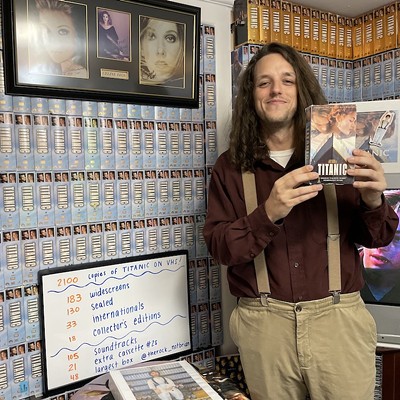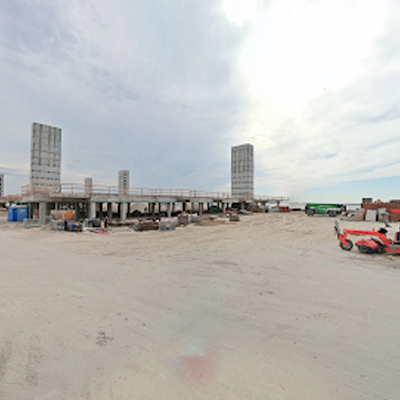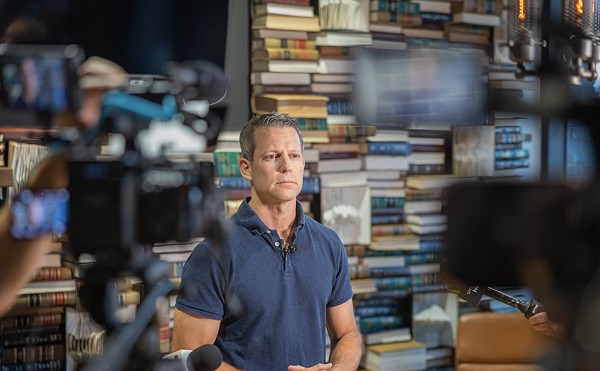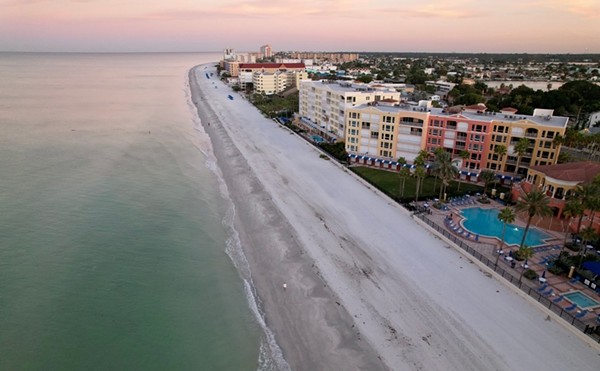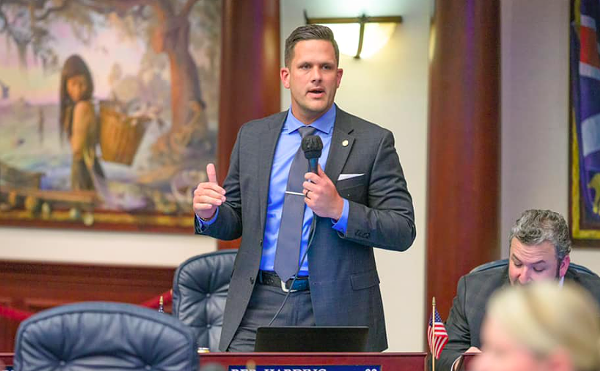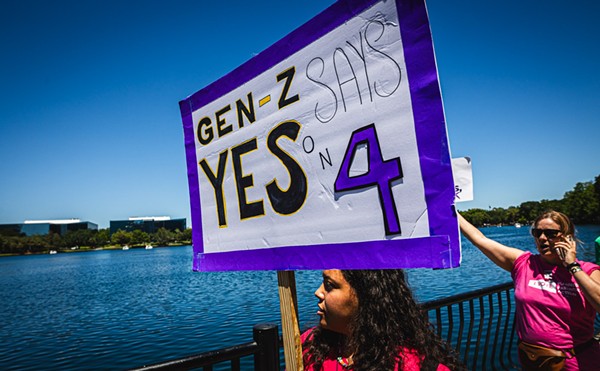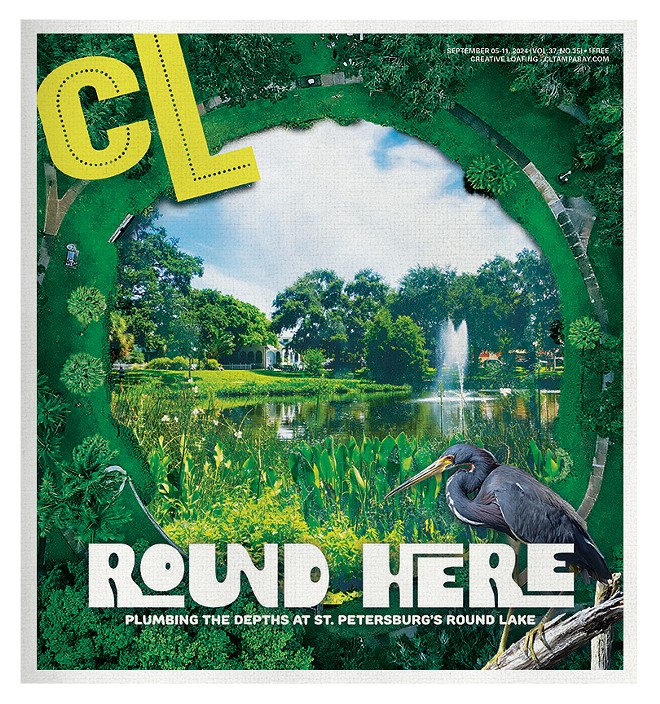
It’s a simmering August morning in St. Petersburg. The sun’s still-slanted light plays through the jigsaw branches of the ancient banyan onto the grassy bank leading down to Round Lake. This tiny oasis, a hidden gem just west of the busy Fourth Street North corridor, shines like a polished tiger eye under the brilliant summer sky. The steady splash of the aeration fountain cools my soul exactly two degrees as perspiration pools along my hairline and creeps down my back. Watching a tricolored heron thread its way through the spikeweed and pickerel along the water’s edge, I feel I’m about ready to give up on my mission—learning more about a decade-long effort to restore the lake’s habitat—and just dive in. Those refreshing depths are calling my name.
But how deep is Round Lake, really? As it turns out, it depends on the year.
Days earlier, in the mercifully cool rooms of the St. Petersburg Museum of History’s archives, I’d seen an 1888 plat of the neighborhood that identified the pool as Deep Water Lake. Just how deep remained unclear. But the presence of two other bodies nearby—“Long Pond” and “Grass Pond”—seemed to suggest it was a deep spot in a chain of marshy lakes that once stretched just north of town. Possibly a sinkhole fed by groundwater. And while this watery triad stuck around for at least another 18 years, appearing again on city plats in 1902 and 1906, by the time St. Pete celebrated its sweet 16 in 1908, there was just one lake with a whole new name: Park Lake.
Looking sweatily around the park, I think that name says so much about the landscape I now see. A square block of lawn, sheltered by mature oaks, stately palms, and the magnificent banyan, slopes gracefully down to the water. The park is ringed by a promenading sidewalk and crowned by a stately gazebo—a replica of the one that originally served as a streetcar stop for folks visiting the park. Beyond the shadows of the trees, old storefronts and historic houses are a gentle suggestion of the city beyond. The lake is a gorgeous centerpiece, so perfectly round that it was sometimes called “Silver Dollar Lake” by the aviators that flew over the city in its early days. This is, as neighbors will attest, a place where folks can escape from the stressors of the city for a while. But it’s a citified sort of nature, sculpted and shaped by the city’s park commission to—as a 1913 writer for the St. Petersburg Daily Times put it—“remove the unsightly marshy places” that ringed its shores and create a true “beauty spot.” Pleasing polygons replaced the messy mire of the past. (See the newspaper clip at the bottom of this story.)“This tiny oasis shines like a polished tiger eye under the brilliant summer sky.”
tweet this
At the edge of my vision, the heron spears a fish with its black-tipped bill.
In the archives, you can watch how this vision of City Beautiful unfolded. In 1914, muck cleared from the park was spread along the St. Pete waterfront to cover the bare sand and provide a foundation for landscaping. In 1916, St. Pete Postmaster and chair of the park board Roy S. Hanna championed the idea of transforming Round Lake into an alligator farm, noting that alligators were rapidly disappearing from their natural habitats in Florida and that Northern tourists expected to see them while visiting. (While this exciting idea never came to pass, one such northerly visitor would open a privately-owned alligator farm to the south of the city just two years later.)
Perhaps the park’s crowning moment came in 1938, when the city marked the 50th anniversary of the arrival of the Orange Belt Railroad at the Festival of States—the yearly celebration in which clubs formed of snowbirds from various parts of the country staged a magnificent parade, with floats showing off their home states. That March, Round Lake hosted a fantastical evening Golden Jubilee Pageant on a towering three-story stage over the lake. Spectators seated on the city’s signature green benches, specially brought in for the occasion, watched as hundreds of performers danced tributes to the sunshine, the railroad, Florida citrus, and Florida flowers, among many other topics. Reporters gushed about the “glory of the scene” as lights reflected off the lake’s placid waters.
Today, it’s the bright green stalks of fireflag and the white speckles of ibis that shine along the lake as I meet Adrian Arabitg, a neighbor who helped form a conservation group known as the Friends of Round Lake. When Arabitg moved to the neighborhood in 2014, he explains, the lake looked very different: there were few if any birds to be found and the surface was clogged with invasive plants, which were regularly treated with pesticides. Since its glory days of Golden Jubilee Pageants and the St. Pete Fishathon (a city-wide kids’ fishing contest begun at Round Lake in 1948), the lake had borne the brunt of the development around it, and had fallen into neglect.
Working with the City, the Historic Uptown Neighborhood Association, Keep Pinellas Beautiful, and a local nonprofit called Stewards of our Urban Lakes (SoUL), Arabitg and his neighbors staged dozens of clean-up days and ended the spraying. They installed a native aquatic plant plot, designed to provide habitat while naturally filtering nutrients from the lake’s water, which has since doubled in size. The birds have returned—and the dog-walkers, bench-sitters, and outdoor yogis and yoginis have followed. “The lake is our gathering place,” Arabitg tells me, as we enjoy the shady retreat of the gazebo. “We just wanted to bring some life back to it.”
But there was one challenge nobody was expecting. In late 2021, Round Lake began to dry up. After a particularly dry winter, water started receding from the lake’s shoreline, leaving exposed lakebed to bake in the sun. By March 2022, the lake had shrunk to about half its original size. “It was basically a mud pit,” Arabitg laments.
Everyone knew that Round Lake depended on rainfall to survive. But a complicating factor was soon discovered by the City: a pump which had been installed in the 1970s to keep the lake full had broken. Simply fixing it wasn’t an option, as pumping groundwater to fill a lake—especially a “manmade” lake without significant connections to the larger ecosystem—had since become illegal. And years of laying down impermeable streets and parking lots in the surrounding neighborhood had limited the lake’s natural groundwater recharge. A temporary fix of repairing the pump and rerouting the water to irrigate the surrounding park (which eventually drains into the lake) is still in place as the City searches for a long term solution.
I scan the lake’s edge, noting an old concrete retaining wall and a small culvert—all part of the complex plumbing that supplies the lake with surface water. I recall another article, dated 1925, which described the installation of a pipe to drain Round Lake into nearby Mirror Lake. Like an overflow hole in a gigantic sink, the pipe was meant to keep the lake’s level manageable, and suppress flooding in the neighborhood, in times of too much rain.
Too much rain, or not enough. My mind returns to the question of depth: in the journey from Deep Water Lake to Round Lake, from messy marsh to perfect park, it seems, the city had taken on the challenge of managing an ecosystem it had just barely begun to understand. And with the hotter temperatures, drier droughts, and fiercer rainfall of climate change now bearing down on us, the flaws in our logic are beginning to show.
But we are learning. Arabitg points out, with pride, that the new plantings not only survived the low water levels but have spread, by themselves, along the lake’s edge. He describes the Friends’ next big project of dredging the southern end of the lake to retain more water, for longer, in dry times. He, along with his colleagues, it strikes me, also demonstrate the difference we can make when we start to really pay attention to how water moves.
In the end, I learn from Jim Bays, President of SoUL, that Round Lake is, on average, only about five feet deep (though, he allows, there’s a significant layer of sediment built up at the bottom, so it’s pretty hard to know for certain). Hardly the underwater wonderland I’d fantasized about, and probably not so great for a swim.
But, as I gulp down the solace of my well-iced water bottle, I have to admit that Round Lake has more than enough depth to set me dreaming. About beauty, resilience, and the changing ways we account for the world’s most precious resource. And maybe, just a little, about alligator farms.
 17 Aug 1913, Sun Tampa Bay Times (St. Petersburg, Florida) Newspapers.com
Subscribe to Creative Loafing newsletters.
17 Aug 1913, Sun Tampa Bay Times (St. Petersburg, Florida) Newspapers.com
Subscribe to Creative Loafing newsletters.Follow us: Google News | NewsBreak | Reddit | Instagram | Facebook | Twitter




